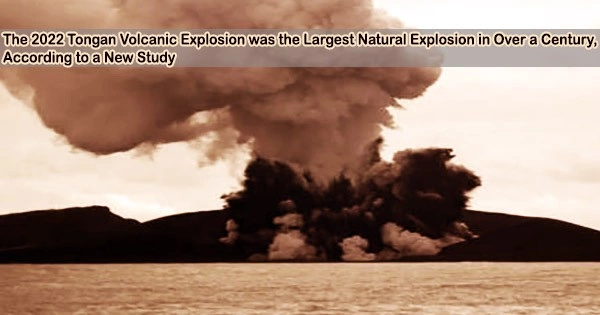According to a new study led by scientists from the University of Miami Rosenstiel School of Marine, Atmospheric, and Earth Science and the Khaled bin Sultan Living Oceans Foundation, the 2022 eruption of an undersea volcano in Tonga was more powerful than the biggest nuclear detonation in the United States.
The 15-megaton volcanic explosion from Hunga Tonga-Hunga Ha’apai, one of the largest natural explosions in more than a century, caused a mega-tsunami with waves up to 45 meters (148 feet) on Tonga’s Tofua Island and 17 meters (56 feet) on Tongatapu, the country’s most populated island.
Rosenstiel School researchers created a tsunami simulation of the Tongan Archipelago using data from the Khaled bin Sultan Living Oceans Foundation Global Reef Expedition and before-and-after satellite imagery, drone mapping, and field observations collected by scientists at The University of Auckland.
The findings demonstrated how the region’s intricate shallow bathymetry served as a low-velocity wave trap, collecting a more than hour-long tsunami with waves as high as 85 meters (279 feet) one minute after the original explosion.
While 2022 may have been a lucky escape, other submarine volcanoes possess the capacity to spawn a future tsunami at the same scale. This eruption holds important lessons for both past and future tsunami in Tonga and beyond. The eruption was an excellent natural laboratory to test hypotheses and models that can be deployed elsewhere to improve future disaster preparations, and better understand similar eruptions and subsequent tsunami as preserved in antiquity and in the geologic record.
Professor Sam Purkis
The submarine volcanic eruption of Hunga Tonga-Hunga Ha’apai, which forms the island chain of Tonga and is a result of the convergence of the Pacific and Indo-Australian tectonic plates, rivaled the 1883 eruption of Krakatau that killed over 36,000 people.
“Despite its size and long duration, the mega-tsumani that resulted from Hunga Tonga-Hunga Ha’apai claimed few lives,” said Sam Purkis, professor and chair of the Department of Marine Geosciences at the Rosenstiel School. “The main factors that led to this, we suggest, are the quirk of the location, the COVID-19 pandemic, and increased evaluation drills and awareness efforts carried out in Tonga in the years prior to the eruption.”
The simulation also revealed that the eruption’s proximity to urban areas spared Tonga from a more disastrous consequence.
“While 2022 may have been a lucky escape, other submarine volcanoes possess the capacity to spawn a future tsunami at the same scale,” said Purkis, who is also chief scientist at the Khaled bin Sultan Living Oceans Foundation. “This eruption holds important lessons for both past and future tsunami in Tonga and beyond. The eruption was an excellent natural laboratory to test hypotheses and models that can be deployed elsewhere to improve future disaster preparations, and better understand similar eruptions and subsequent tsunami as preserved in antiquity and in the geologic record.”
The study was supported by grants from the Khaled bin Sultan Living Oceans Foundation Global Reef Expedition, NASA Goddard Space Flight Center and the University of Auckland, and the New Zealand Ministry of Business, Innovation and Employment, Endeavour Fund Project.





